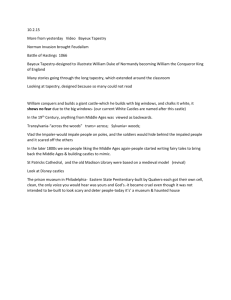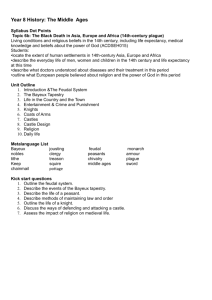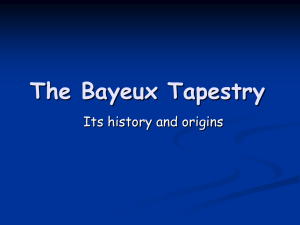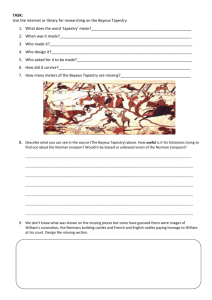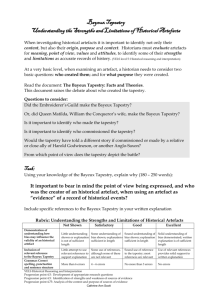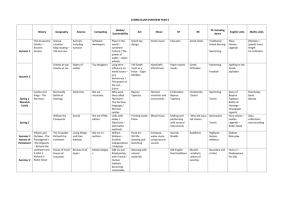Ville de Bayeux
advertisement
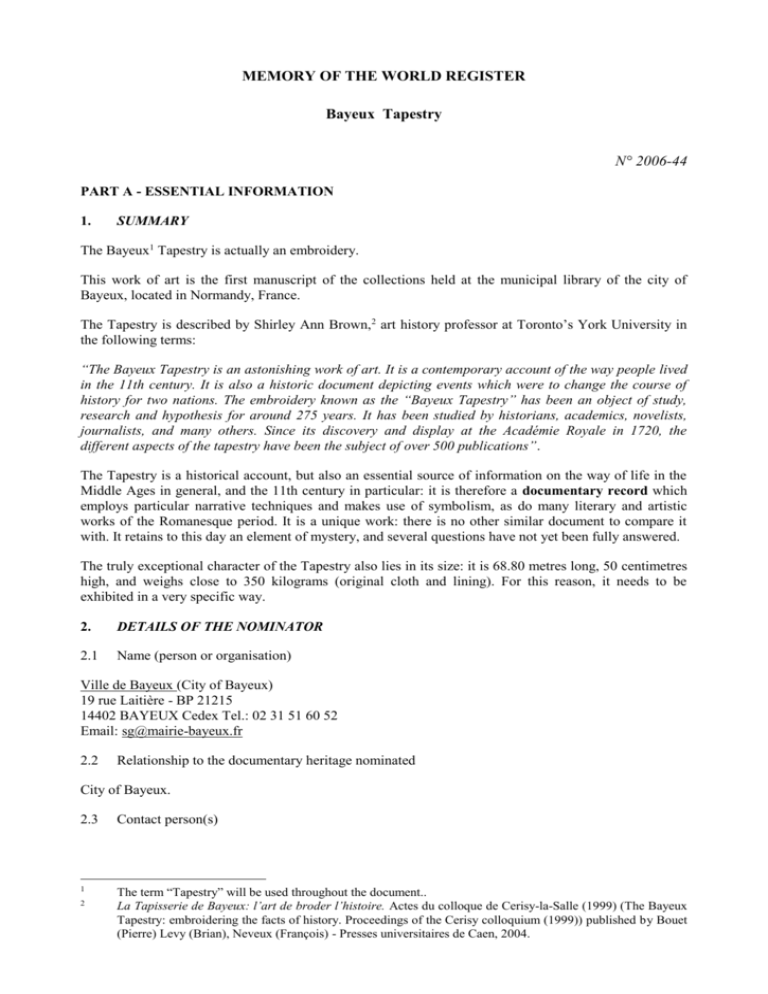
MEMORY OF THE WORLD REGISTER Bayeux Tapestry N° 2006-44 PART A - ESSENTIAL INFORMATION 1. SUMMARY The Bayeux1 Tapestry is actually an embroidery. This work of art is the first manuscript of the collections held at the municipal library of the city of Bayeux, located in Normandy, France. The Tapestry is described by Shirley Ann Brown,2 art history professor at Toronto’s York University in the following terms: “The Bayeux Tapestry is an astonishing work of art. It is a contemporary account of the way people lived in the 11th century. It is also a historic document depicting events which were to change the course of history for two nations. The embroidery known as the “Bayeux Tapestry” has been an object of study, research and hypothesis for around 275 years. It has been studied by historians, academics, novelists, journalists, and many others. Since its discovery and display at the Académie Royale in 1720, the different aspects of the tapestry have been the subject of over 500 publications”. The Tapestry is a historical account, but also an essential source of information on the way of life in the Middle Ages in general, and the 11th century in particular: it is therefore a documentary record which employs particular narrative techniques and makes use of symbolism, as do many literary and artistic works of the Romanesque period. It is a unique work: there is no other similar document to compare it with. It retains to this day an element of mystery, and several questions have not yet been fully answered. The truly exceptional character of the Tapestry also lies in its size: it is 68.80 metres long, 50 centimetres high, and weighs close to 350 kilograms (original cloth and lining). For this reason, it needs to be exhibited in a very specific way. 2. DETAILS OF THE NOMINATOR 2.1 Name (person or organisation) Ville de Bayeux (City of Bayeux) 19 rue Laitière - BP 21215 14402 BAYEUX Cedex Tel.: 02 31 51 60 52 Email: sg@mairie-bayeux.fr 2.2 Relationship to the documentary heritage nominated City of Bayeux. 2.3 Contact person(s) 1 The term “Tapestry” will be used throughout the document.. La Tapisserie de Bayeux: l’art de broder l’histoire. Actes du colloque de Cerisy-la-Salle (1999) (The Bayeux Tapestry: embroidering the facts of history. Proceedings of the Cerisy colloquium (1999)) published by Bouet (Pierre) Levy (Brian), Neveux (François) - Presses universitaires de Caen, 2004. 2 Sylvette LEMAGNEN, curator, médiathèque municipale de Bayeux (Bayeux municipal media library). Olivier LE BOT, directeur général des services (director of services), City of Bayeux. 2.4 Contact details (include address, phone, fax, email) Sylvette LEMAGNEN, curator, médiathèque municipale de Bayeux (Bayeux municipal media library) Centre Guillaume le Conquérant 2 rue aux Coqs - BP 21215 14402 BAYEUX Cedex Tel: 02 31 51 20 20 Fax: 02 31 51 20 21 Email: mediatheque@mairie-bayeux.fr Olivier LE BOT, directeur général des services (director of services) Ville de Bayeux 19 rue Laitière - BP 21215 14402 BAYEUX Cedex Tel.: 02 31 51 60 52 Fax: 02 31 51 60 70 Email: sg@mairie-baveux.fr 3. IDENTITY AND DESCRIPTION OF THE DOCUMENTARY HERITAGE 3.1 Name and identification details of the items being nominated Tapisserie de Bayeux - broderie - dite de la Reine Mathilde. (Bayeux Tapestry – an embroidery also known as “Queen Matilda’s Tapestry”). 3.2 Description La Tapisserie de Bayeux - broderie - dite de la Reine Mathilde3 (Bayeux Tapestry – an embroidery also known as “Queen Matilda’s Tapestry). The Bayeux Tapestry chronicles the conquest of England, from 1064 to 1066, by William the Conqueror, Duke of Normandy. The embroidery was fashioned by needle on a thin, fairly even linen cloth. It is made up of nine identical widths of cloth, each of unequal length, assembled by oversewing. The embroidery is carried out using stem stitch for the outlines and couching stitch for filling in most of the figures. Also, chain stitch and split stitch, using coloured wool threads and bay-coloured linen threads,4 were used to give the effect of greater relief to certain letters and patterns, such as arrows, spears and ropes. The colours used have no naturalist function. 4. JUSTIFICATION FOR INCLUSION/ ASSESSMENT AGAINST CRITERIA 4.1 Authenticity Historiographical approach to the embroidery5 The Tapestry was reported for the first time in the inventory of the Bayeux Cathedral Treasure in 1476. It was rediscovered by Nicolas Joseph Foucault, intendant of Caen from 1689 to 1704. It was displayed in March 1803 in Paris, at the request of Bonaparte. 3 4 5 Appendix No. 1 Gabriel Vial, Analyse technique de la Broderie de Bayeux, 1988, Monuments Historiques. Brigitte Oger, La Tapisserie de Bayeux: le bilan de l’expertise scientifique (1982-1983), LRMF section textile (research laboratory, French museums, textiles division). Based on: Shirley Ann Brown, The Bayeux Tapestry: history and bibliography. Woodbridge, Boydell Press, 1998. 2 The essential questions are: - who was the author, or instigator of the Tapestry? - was it made in Normandy or England? - when was it made? There is no contemporary account of the history of the origins of the Tapestry, nor of the conditions in which it was made. One thing is certain: the Tapestry existed and was found in the North of France towards 1100.6 One likely hypothesis is that the embroidery was made in the south of England, and commissioned by Odo, Bishop of Bayeux and William’s half-brother (he is depicted several times in the tapestry). However, the design of the work, and its great consistency from start to finish suggest that its production was supervised by a man, probably a cleric, because of the knowledge of Latin demonstrated. 7 The embroidery was, however, probably fashioned by embroideresses, known to exist in the south of England at that time. The Tapestry could have been designed to decorate Bayeux Cathedral at its consecration in 1077, or the reception room of a private residence. Considering the Tapestry’s size (50 cm high) it would seem more suited to the decoration of a private residence. However, its presentation on the Saint John Feast of Relics, - a tradition which lasted until the Revolution – suggests that it was designed to decorate the chancel of the cathedral at its consecration on 14 July 1077. The Tapestry is not only a historical account; it is also a documentary record for which there are two conflicting hypotheses: according to the first the Tapestry is a religious representation, while according to the second the representation is epic. Some historians argue that the Tapestry’s creator took the conquest of Judah by Babylon as the paradigm for the events of his own time. For example: - the portable reliquary on which Harold swears his oath is similar to the Ark of the Covenant; the false oath sworn on the holy relics leads to defeat through divine punishment. - William’s adoption of the winged lions – the symbol of Babylon in the visions of Daniel, the Old Testament prophet; - the blinding of the king who swore a false oath: Harold was killed by an arrow piercing his eye, just as Zedekiah was blinded by Nebuchadnezzar; - decapitation: close by to Harold, an unarmed soldier is beheaded – a scene reproduced in line with the decapitation of the sons of Zedekiah. For others the Tapestry is a secular work, which recounts, in the manner of an Anglo-Saxon epic poem, the heroic fight of valiant warriors. This poetic form used irony and understatement: the poet was inclined to see both sides of the story, and expected his audience to understand his means of expression, and accuse nobody. As an example we can take the 14th-century poem The Battle of Maldon which, like the Tapestry, tells the tale – without taking sides – of a heroic battle of life and death, of which the poet (and artist) chooses to illustrate certain moments. 6 7 Poem by Baudri de Bourgueil. Appendix No. 2 3 Whether the Tapestry’s subject matter is religious or secular,8 it is an established fact that it recounts a military triumph: the conquest of England by William the Conqueror. The work reveals various influences and it is possible to identify a number of sources: - the long, narrow, mural cloths of popular tradition in Northern Europe (Scandinavia); - Anglo-Saxon biblical manuscripts (such as The Old English Hexateuch by Aelfric or the Genesis by Caedmon, which have a similar type of narration: separate consecutive episodes are presented in the form of a continuous tale, with spatial continuity on the support used; - classical columns, such as Trajan’s Column, on which the spiral bas relief commemorates a military victory. According to the theory by Otto Werckmeister, the Tapestry was influenced by such columns, commemorating, in continuous narration, a methodically prepared, victorious military campaign. Although this theory is not sufficiently substantiated, the Tapestry’s author could well have known about the existence of these columns, and even have seen them in Rome. - the Joshua Roll, a Byzantine manuscript dating from the year 1000, kept in the Vatican Library, which also recounts a military triumph – that of the Israelites over the Canaanites. Scientific approach The fibres have been identified through optical microscope observation. A total of 25 thread samples 9 were analysed: wool, linen, hemp and one cotton thread were identified. The dyes of the 160 sample threads, whether used originally or during restoration, were analysed by thin layer chromatography. For the original dyes, analysis revealed the presence of compounds used in the Middle Ages, such as: - luteolinidin and apigeninidin, found in dyer’s rocket, - alizarin and purpurin, found in madder, - indigotin, obtained from pastel leaves or indigo, - no use of tannins. The synthetic dyes show clearly which parts of the Tapestry are restored, and thus which parts are original. Restoration operations used synthetic-dye threads, which dates the restoration to post-1860. 4.2. World significance, uniqueness and irreplaceability World significance In the West, research has been carried out to determine the existence of similar works. There is no equivalent item dating from the 11th century; only fragments of Nordic tapestries dating from the 9th and 12th centuries have been found.10 8 9 10 Appendix No. 3 Gabriel Vial, Analyse technique de la Broderie de Bayeux, 1988, Monuments Historiques. Brigitte Oger, La Tapisserie de Bayeux: le bilan de l’expertise scientifique (1982-1983), LRMF section textile (research laboratory, French Museums, textiles division). Woven wool tapestry fragments found in 1904 among the furnishings of the Oseberg burial ship, south-west Oslo. This was probably a royal burial. Norwegian fragment found in 1867 in the burial mound at Haugen Farm at Rolvsoy, dated around 900. Three tapestry strips found in 1910 at the Överhogdal church in Sweden (today the Jamtli Museum in Ostersund). 12th-century tapestry from Hoylandet in Norway, in the Trondheim Museum: Adoration of the Kings, in blue and white on a red background. Skog Tapestry, Halsingland dated around 1050-1150 Appendix No. 4. 4 Furthermore, the Tapestry provides information on the Norman conquest of England that is not included in any text of that era,11 such as information on the Brittany expedition and the Bayeux oath. Its world significance can be shown in several respects. First, it is a masterpiece of creativity, which presents a remarkable unity of style, the aesthetic quality of which is undeniable. Along the top and bottom of the main scene, two borders frame and supplement the story with animal designs, sometimes recalling Aesop’s fables such as The Fox and the Crow and sometimes describing everyday scenes: birds being caught with slings, for example, or fields being ploughed with a harrow. Furthermore, in some scenes, where there is considerable tension between the protagonists, or at key moments of the story, the embroidery of the central scene overlaps onto the upper border. When the subject extends beyond the central frame, this increases the effect of movement, cleverly suggesting animation. The technique of narration – the continuous unfolding of the story, scene by scene – and the graphics reinforced by raised strands of wool, creating a light/shadow effect, suggest a “cartoon” technique. Secondly, let us remember how much the Normans liked to travel: their Viking ancestors the Northmen, having arrived from the Nordic countries, travelled up the Seine, settling and founding a line there, before leaving again, time and time again. Thus, Romanesque art is a mixture of diverse influences, the main sources of which come from:12 - Barbarian art (longships, furnishings); - Byzantine art, featuring flat, un-embossed figures copied from mosaics; - Muslim art, from which the trefoil and polylobed arches, and the arches with black and white voussoirs are borrowed; - Sassanid Persian art, for the affronted griffons and the sacred fire between the lions; - Coptic art from the period of early Christianity in Egypt, which accounts for the capitals, the interlacing, the bestiarii – like the lions – facing each other; many 11th-century churches and crypts show these decorations, which are also present in the Tapestry. Lastly, the world significance of the Bayeux Tapestry can also be seen in terms of its accessibility to a large audience. For what manuscript today can be seen 360 days a year by approximately 400,000 visitors? And how else can we explain why a Canadian artist, from illustrations taken from magazines, has painted the Tapestry on a canvas which is now shown in the cathedral during the celebration of the Medieval Feasts in the first weekend of July?13 4.3 Is one or more of the criteria of (a) time (b) place (c) people (d) subject and theme (e) form and style satisfied? (see 4.2.5) Time This large-scale textile work of the 11th century is, to our knowledge, the only one of its kind to have survived to the present day. The Tapestry is an almost contemporary visual record of the event it depicts, 11 12 13 Chronicles of William of Jumièges, William of Poitiers and Ordéric Vital. Poems by Baudri de Bourgueil and The Charter of William the Conqueror. Appendix No. 5 Appendix No. 6 5 one of the most significant events of Medieval times. It tells of the beginnings of the Norman Conquest; the landing of Norman and French troops in England and the Battle of Hastings. It also shows how people lived in the 11th century. The Tapestry was probably made in 1077 or thereabouts – at the latest by 1082, when Odo, Bishop of Bayeux, fell into disgrace and was imprisoned by his half-brother William. Place The Tapestry was probably made in the south of England, perhaps in Canterbury (an important cultural centre in the Middle Ages) or in Winchester (a centre for embroidery at the time), having been commissioned by Odo, Bishop of Bayeux and half-brother of William the Conqueror. Designed to decorate Bayeux Cathedral at its consecration in 1077 or to adorn the reception room of a private residence, the Tapestry provides very detailed information on costumes, military and civil architecture, military equipment, navigation and agricultural practice in Normandy and England in the Middle Ages People This historical document depicts events which were to change the course of history. One theory14 maintains that each visitor can read his or her own interpretation into the Tapestry, depending on ethnic origin or political allegiance. The Tapestry was intended for the new Anglo-Norman court, made up of French and Saxon aristocrats, the idea being to persuade the English to accept the new social order. There are three levels of meaning in the Tapestry: - the intentional: the point of view of Norman propaganda; - the non-intentional: reflection of the daily life and role of social classes in contemporary society; - the “subversive”: the voice of the oppressed classes of Anglo-Norman society (conquered English, women, and lower classes). Subject and theme The Tapestry provides a rich, lively account of the events of 1064-1066, or William’s conquest of England. The epic tale recounted by the Tapestry starts in 1064, when the aged King Edward of England, who has no direct heir, sends Harold, his brother-in-law, to Normandy in order to offer the crown to William, whom he designates as his successor. However, despite the oath of allegiance sworn to William, Harold seizes the crown of England when Edward dies in 1066. It only takes a few months for William to prepare his troops and lead them to victory, at Hastings where Harold and his army are defeated on 14 October 1066. The Tapestry informs us of war and everyday life in the early Middle Ages. Simone Bertrand15 counted: - 626 people, - 202 horses and mules, - 55 dogs, 14 S. Lewis. The Rhetoric of Power in the Bayeux Tapestry. Cambridge: Cambridge University Press, 1999. 15 Simone Bertrand was curator of the Tapestry Museum from 1948 to 1978. 6 - 505 animals of all kinds, - 37 fortresses or buildings, 41 ships or vessels, - innumerable various objects. Form and style The Tapestry is a coherent, precise work, which employs codification to clarify the tale being told and to help spectators follow the events unfolding before their eyes. The linguistic status of the Tapestry is more complex than that of a work of literature. There are two types of explicit discourse used to produce the message: - the iconographical discourse - the literary discourse of the inscriptions. The Tapestry was probably first prepared by a draughtsman: its graphics, architectural frames and detail of decoration are expressions of the 11th-century art of illumination. The narrative “cartoon” technique of the Tapestry, with its scenes separated by trees, is inspired by the 9th-century Carolingian manuscripts, in particular those of Tours. The overall composition of the scenes is similar to those of the Canterbury Manuscripts. The Tapestry relates to some very particular currents of the Romanesque period, in particular the types of letters and designs used (importance of designs of Scandinavian origin, plant designs and animal themes). The range of colours used in the Bayeux Tapestry has hardly any exact equivalent in the Norman art of illumination, at least not before the end of the 11th century. However, the association of brown, beige, bronze green, blue-black or dark blue, and yellow highlights are frequently found in Anglo-Saxon manuscripts. Similarly, fairly close equivalents can be found in mural paintings. Lastly, some specific features16 confirm the English style of the Tapestry, particularly the written forms and the etymology 4.4 Issues of rarity, integrity, threat and management Rarity Large-scale works of art celebrating military victories were relatively common at this period, since they are referred to in historical or literary accounts. However, almost no physical trace of them remains, and there is no description of the style, techniques employed or dimensions of such works. In terms of both its content and physical nature, the Bayeux Tapestry is a unique work, dating from the 11th century. It is the only work of its size to have survived to this day. Integrity The cloth of the Tapestry has undergone 518 repairs at different periods. The Tapestry was lined with a second linen cloth between the 15th and 17th century. The embroidery was restored in the 19th century. The last lining operation in the 19th century resulted in 2 or 3 cm of the upper part of the Tapestry being cut off, where an old fixation system had been located. Threat The Tapestry is not in any immediate danger. It is displayed in a specially designed display cabinet and is protected by a burglar-proof pane. However, in the event of a disaster, it cannot be evacuated. 16 Appendix No. 7 7 Management There is a management plan: - temperature/humidity control, - fire safety. 5. Legal information 5.1 Owner of the documentary heritage (name and contact details) The French State. 5.2 Custodian of the documentary heritage (name and contact details, if different to owner) Ville de Bayeux 19 rue Laitière - BP 21215 14402 BAYEUX Cedex Tel.: 0231 51 6052 Fax: 02 31 51 60 70 Email: sg@mairie-bayeux.fr 5.3 Legal status Category of ownership The Tapestry is classed as a bien national. It came into state ownership after confiscation in 1790 by the authorities during the French Revolution. Accessibility The Bayeux Tapestry is exhibited in the Centre Guillaume Le Conquérant (William the Conquerer Centre) in Bayeux, France. The centre is open every day except from 24 December p.m. to 26 December a.m.; from 31 December p.m. to 2 January a.m.; and in the second week of January, from Monday to Friday. There is access for disabled persons. Copyright status None. Responsible administration Médiathèque municipale de Bayeux (Bayeux municipal media library), on behalf of the French state. 6. Management plan 6.1 Is there a management plan in existence for this documentary heritage? YES/NO The Bayeux Tapestry is currently exhibited in a reinforced display cabinet designed by Mr Duval, Architecte en chef des Monuments Historiques (chief architect, Historic Buildings). Temperature and humidity are controlled by sensors, and are maintained at constant levels. Lighting is via a low-intensity lighting track inside the cabinet, while the public gallery, covered with a half-hull structure, is kept in darkness. Presentation is convex, on a central core around which visitors walk. The Tapestry’s fixation system was designed by the Ecole Boulle art school: it consists of rollers fixed to a rail attached around the entire display case, enabling the Tapestry to be demounted. For it to be 8 suspended, a support was designed, consisting of different natural textiles which have now proven to be inadequate: they overlap onto the original cloth and stiffen it. The base of the cabinet is sealed by chipboard panels. Lastly, concerning the fire risk, inert-gas canisters have been installed in the control room. The gas used – Inergen – is a mixture of nitrogen, argon and carbon dioxide, which extinguishes fire by reducing the oxygen content in the atmosphere. The only problem is that this gas is very dangerous for humans and, if used, means that nobody can enter the Tapestry control room. 7. Consultation 7.1. Provide details of consultation about this nomination with (a) the owner of the heritage (b) the custodian (c) your national or regional Memory of the World committee Letters of consultation were sent in January 2006 to the Regional Directorate of Cultural Affairs of Lower Normandy; the Directorate of Books and Reading and the Directorate of Architecture and Heritage (Ministry of Culture and Communication). The French National Commission for UNESCO was consulted on 31 January 2006. PART B – SUBSIDIARY INFORMATION 8. ASSESSMENT OF RISK 8.1 Detail the nature and scope of threats to this documentary heritage (see 5.5) The Bayeux Tapestry is subjected on a daily basis to serious stress: - it is exhibited 360 days a year; - one panel of the Tapestry’s display cabinet was found to have a 5 cm-diameter crack, and was replaced in January 2006; - the materials used inside the display cabinet have now proven to be inadequate (possibility of woodchip panels releasing formaldehyde); - the current display system does not allow for the Tapestry’s safe evacuation in the event of a disaster, owing to: ° the considerable time required to demount the Tapestry; ° the weight of the transport crate; ° the small control room exits, which are not large enough to allow the crate through; ° bars on the windows of the exhibition hall; - the building in which the Tapestry is housed is located in a flood-risk zone; - the city of Bayeux is located on the edge of a seismic zone (the building does not meet anti-seismic standards). 9. Assessment of preservation 9.1 Detail the preservation context of the documentary heritage (see 3.3) The constituent materials are in good condition given the Tapestry’s “age”. 9 However: - the many restoration operations have created points of tension in some areas of the original linen cloth, and damaged the original elements; - many earlier restoration operations have deteriorated; - some wool threads have become discoloured; - blocks of colour have been transferred onto the lining as a result of previous intense exposure to light; - the cloths are in very poor mechanical condition, and in many places have small tears. Temperature and humidity Temperature and humidity are controlled by sensors, and maintained constant. Lighting There is a low-intensity lighting track inside the display cabinet. The public gallery is kept in darkness, but the display lighting is on for long periods of time. Atmospheric pollutants Hygrometry and temperature are controlled. Atmospheric pollutants have not been studied. Presence of animals and insects None. Physical safety The museum displaying the Tapestry is guarded (on-site) 24 hours a day. There are burglar and fire alarms. Video-surveillance equipment was installed in January 2006. PART C - LODGEMENT This nomination is lodged by: Mr Patrick GOMONT, Mayor of Bayeux Signature Bayeux, 10 March 2006 10
